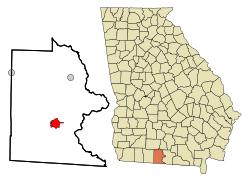Quitman, Georgia
Quitman, Georgia | |
|---|---|
 County courthouse | |
 Location in Brooks County and the state of Georgia | |
| Country | United States |
| State | Georgia |
| County | Brooks |
| Area | |
| • Total | 3.8 sq mi (10 km2) |
| • Land | 3.8 sq mi (9.9 km2) |
| • Water | 0 sq mi (0.1 km2) |
| Elevation | 190 ft (58 m) |
| Population (2000) | |
| • Total | 4,638 |
| • Density | 1,220.5/sq mi (463.8/km2) |
| Time zone | UTC-5 (Eastern (EST)) |
| • Summer (DST) | UTC-4 (EDT) |
| ZIP code | 31643 |
| Area code | 229 |
| FIPS code | 13-63224Template:GR |
| GNIS feature ID | 0321256Template:GR |
This article is about the Georgia city. For the county in the same state see Quitman County, Georgia.
Quitman is a city in Brooks County, Georgia, United States. The population was 4,638 at the 2000 census. The city is the county seat of Brooks CountyTemplate:GR.
Quitman was the final home of James Pierpont, author of "Jingle Bells". He was organist for the First Presbyterian Church.[1] A local Quitman ordinance prohibits chickens from crossing the road.[2]
It is called the Camelia City as the tree grows in profusion around the area. Radio station WLYX 96.7 is licenced to broadcast from Quitman.
Geography
Quitman is located at 30°47′05″N 83°33′39″W / 30.784677°N 83.560747°W.Template:GR
According to the United States Census Bureau, the city has a total area of 3.8 square miles (10.0 km²), of which, 3.8 square miles (9.9 km²) of it is land and 0.04 square miles (0.1 km²) of it (0.52%) is water.
Demographics
As of the censusTemplate:GR of 2000, there were 4,638 people, 1,707 households, and 1,131 families residing in the city. The population density was 1,211.1 people per square mile (467.6/km²). There were 2,034 housing units at an average density of 531.1/sq mi (205.0/km²). The racial makeup of the city was 30.98% White, 66.36% African American, 0.13% Native American, 0.37% Asian, 1.06% from other races, and 1.10% from two or more races. Hispanic or Latino of any race were 2.18% of the population.
There were 1,707 households out of which 31.3% had children under the age of 18 living with them, 31.9% were married couples living together, 30.2% had a female householder with no husband present, and 33.7% were non-families. 30.4% of all households were made up of individuals and 14.2% had someone living alone who was 65 years of age or older. The average household size was 2.61 and the average family size was 3.26.
In the city the population was spread out with 30.1% under the age of 18, 8.8% from 18 to 24, 22.9% from 25 to 44, 20.3% from 45 to 64, and 17.9% who were 65 years of age or older. The median age was 35 years. For every 100 females there were 78.6 males. For every 100 females age 18 and over, there were 68.6 males.
The median income for a household in the city was $20,924, and the median income for a family was $24,154. Males had a median income of $22,727 versus $17,391 for females. The per capita income for the city was $10,594. About 31.2% of families and 34.2% of the population were below the poverty line, including 46.7% of those under age 18 and 20.9% of those age 65 or over.
History

The Quitman Historic District, which is listed on the National Register of Historic Places, contains late 19th and early 20th century brick buildings in the commercial district and mainly wood frame homes from various periods and styles in the residential area. The streets are laid out in a grid with several central parks.
Education
Brooks County School District
The Brooks County School District holds grades pre-school to grade twelve, that consists of two elementary schools, a middle school and a high school.[3] The district has 167 full-time teachers and over 2,563 students.[4]
- North Brooks Elementary School
- Quitman Elementary School
- Brooks County Middle School
- Brooks County High School
References
- ^ Jingle Bell history page
- ^ Sheryl Lindsell-Roberts, Loony Laws & Silly Statutes, Sterling Publishing Co., Inc., 1994. ISBN 0806904720
- ^ Georgia Board of Education, Retrieved May 31, 2010.
- ^ School Stats, Retrieved May 31, 2010.
External links
 Media related to Quitman, Georgia at Wikimedia Commons
Media related to Quitman, Georgia at Wikimedia Commons

